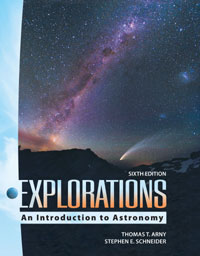 
Explorations: Introduction to Astronomy (Arny), 6th EditionChapter 9:
The Terrestrial Planets  <a onClick="window.open('/olcweb/cgi/pluginpop.cgi?it=jpg::::/sites/dl/free/0010202009/220722/chapter9.jpg','popWin', 'width=NaN,height=NaN,resizable,scrollbars');" href="#"><img valign="absmiddle" height="16" width="16" border="0" src="/olcweb/styles/shared/linkicons/image.gif"> (74.0K)</a> <a onClick="window.open('/olcweb/cgi/pluginpop.cgi?it=jpg::::/sites/dl/free/0010202009/220722/chapter9.jpg','popWin', 'width=NaN,height=NaN,resizable,scrollbars');" href="#"><img valign="absmiddle" height="16" width="16" border="0" src="/olcweb/styles/shared/linkicons/image.gif"> (74.0K)</a> | |
- The outer planets are Jupiter, Saturn, Uranus and Neptune.
- Jupiter, Saturn, Uranus, and Neptune (also called the Jovian planets) are much larger than the Earth.
-
They are rich in hydrogen gas and/or its compounds, such as water, ethane, and ammonia.
- They have deep, thick atmospheres and no solid surface.
- They have many moons and rings.
- The Dwarf Planets Pluto and Eris are also members of this remote part of the Solar System. They are far smaller than the giant planets and are composed of ice and rock.
|
 |  |
|





